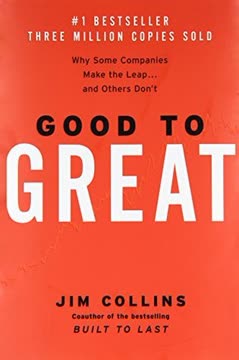Điểm chính
1. The CASHFLOW Quadrant: Understand Your Financial Position
The CASHFLOW Quadrant represents the different methods by which income or money is generated.
The four quadrants. The CASHFLOW Quadrant consists of:
- E (Employee): Work for someone else
- S (Self-employed): Own a job
- B (Business owner): Own a system
- I (Investor): Money works for you
Each quadrant requires different skills, mindsets, and approaches to money. Understanding which quadrant you're in and where you want to be is crucial for financial success.
2. Shift from Employee to Business Owner and Investor
To reduce your taxes, buy a bigger house and get deeper into debt so you can get a tax write-off.
Challenge conventional wisdom. The traditional advice of getting a good job, buying a big house, and relying on tax deductions often leads to financial struggle. Instead:
- Focus on building businesses (B quadrant)
- Invest in income-generating assets (I quadrant)
- Prioritize cash flow over job security
- Learn to create systems that generate wealth
This shift requires a change in mindset and approach to money, moving from seeking security to pursuing financial freedom.
3. Develop Financial Intelligence and Literacy
Financial intelligence is not so much how much money you make, but how much money you keep, how hard that money works for you, and how many generations you keep it for.
Key components of financial intelligence:
- Understanding financial statements
- Recognizing the difference between assets and liabilities
- Managing cash flow effectively
- Knowing how to leverage debt
Developing financial intelligence involves continuous learning, practicing with real-world situations, and challenging your assumptions about money.
4. Overcome Emotional Barriers to Wealth
Success is a poor teacher. We learn the most about ourselves when we fail… so don't be afraid of failing.
Identify and address emotional obstacles:
- Fear of failure
- Need for security
- Desire for instant gratification
- Perfectionism
Overcoming these emotional barriers requires:
- Embracing failure as a learning opportunity
- Developing a long-term perspective
- Practicing delayed gratification
- Taking calculated risks
5. Create Assets and Manage Cash Flow
Your profit is made when you buy… not when you sell.
Focus on building assets. Key strategies include:
- Identifying opportunities to create or acquire assets
- Prioritizing cash flow-generating investments
- Understanding market cycles and timing
- Reinvesting profits to grow your asset base
Effective cash flow management involves:
- Paying yourself first
- Minimizing expenses
- Using debt strategically
- Continuously monitoring and adjusting your financial strategy
6. Distinguish Between Good Debt and Bad Debt
Good debt was debt that someone else paid for you, and bad debt was debt that you paid for with your own sweat and blood.
Leverage debt wisely:
- Good debt: Finances assets that generate income (e.g., rental properties)
- Bad debt: Finances liabilities or consumables (e.g., credit card debt)
Strategies for using debt effectively:
- Invest in assets with positive cash flow
- Understand and utilize tax advantages
- Constantly educate yourself on financial strategies
- Always consider the long-term implications of debt
7. Solve Financial Problems to Create Opportunities
If you want to acquire great wealth quickly, take on great financial problems.
Seek out and solve problems. Wealth creation often comes from:
- Identifying market inefficiencies
- Providing solutions to complex financial issues
- Turning around distressed assets or businesses
Developing problem-solving skills:
- Start small and learn from each experience
- Network with other problem solvers
- Continuously educate yourself on various industries and markets
- Be willing to take calculated risks
8. Build a Business Before Becoming an Investor
To be successful as a "B," you must be able to control the direction your cash flow is flowing.
Prioritize business ownership:
- Develop systems that generate income
- Learn to lead and manage people
- Create value through products or services
- Build a brand and market presence
Benefits of building a business before investing:
- Generates cash flow for investments
- Provides practical financial and management experience
- Develops a network of contacts and resources
- Offers tax advantages and asset protection strategies
9. Take Control of Your Financial Education
If you cannot read numbers, then you must take someone else's opinion.
Invest in your financial knowledge:
- Read financial books and newspapers
- Attend seminars and workshops
- Play financial education games (e.g., CASHFLOW)
- Seek mentors with proven financial success
Continuous learning strategies:
- Set aside time each week for financial education
- Apply new knowledge to real-world situations
- Join or create a study group focused on financial literacy
- Challenge your assumptions and seek diverse perspectives
10. Embrace Risk and Avoid Being Risky
Being uneducated is risky.
Understand and manage risk:
- Differentiate between calculated risks and reckless behavior
- Develop strategies to mitigate potential losses
- Continuously educate yourself on market trends and opportunities
- Build a diverse network of advisors and partners
Strategies for smart risk-taking:
- Start small and scale up as you gain experience
- Always have an exit strategy
- Regularly review and adjust your risk tolerance
- Learn from both successes and failures
11. Choose Your Investor Type and Financial Fast Track
The direction of cash flow is everything.
Identify your investor type:
- Type A: Seeks problems to solve
- Type B: Seeks expert advice
- Type C: Avoids financial responsibility
Strategies for finding your financial fast track:
- Develop expertise in solving specific financial problems
- Build a network of trusted advisors and partners
- Focus on your strengths and delegate weaknesses
- Continuously seek opportunities to learn and grow
Cập nhật lần cuối:
FAQ
What's Rich Dad's Cashflow Quadrant about?
- Financial Freedom Focus: The book explores achieving financial freedom by understanding different income sources through the CASHFLOW Quadrant.
- Quadrant Categories: It categorizes individuals into four types: Employee (E), Self-employed (S), Business owner (B), and Investor (I).
- Mindset Differences: The left side (E and S) focuses on job security, while the right side (B and I) emphasizes wealth creation and financial independence.
- Path to Change: Kiyosaki encourages moving from the left to the right side of the Quadrant for financial freedom.
Why should I read Rich Dad's Cashflow Quadrant?
- Transformative Insights: The book challenges conventional beliefs about job security and wealth, offering new perspectives on money.
- Practical Guidance: It provides actionable steps and strategies for achieving financial independence.
- Relatable Examples: Kiyosaki shares personal anecdotes and lessons from his "rich dad," making the concepts easy to understand and apply.
What are the key takeaways of Rich Dad's Cashflow Quadrant?
- Quadrant Understanding: Recognizing where you currently stand in the Quadrant helps identify your path to financial freedom.
- Financial Education Importance: Kiyosaki stresses the need for financial education to navigate money management and investing complexities.
- Mindset Shift: A significant takeaway is shifting from seeking job security to pursuing financial freedom through entrepreneurship and investing.
What is the CASHFLOW Quadrant in Rich Dad's Cashflow Quadrant?
- Four Income Sources: The Quadrant categorizes income sources as Employee (E), Self-employed (S), Business owner (B), and Investor (I).
- Left vs. Right Side: The left side (E and S) is about job security, while the right side (B and I) focuses on wealth through business and investments.
- Path to Financial Freedom: Understanding the Quadrant helps individuals identify their current financial situation and steps to improve it.
How does Rich Dad's Cashflow Quadrant define an asset and a liability?
- Asset Definition: An asset is something that puts money into your pocket, like rental properties or dividend-paying stocks.
- Liability Definition: A liability takes money out of your pocket, such as debts and expenses that do not generate income.
- Understanding Importance: Kiyosaki emphasizes understanding these definitions to make informed financial decisions, as many mistakenly consider liabilities as assets.
How can I transition from the E or S quadrant to the B or I quadrant according to Rich Dad's Cashflow Quadrant?
- Education and Learning: Financial education is crucial for making informed decisions and understanding the market.
- Start Small: Begin with small steps towards entrepreneurship or investing to gain experience and confidence.
- Seek Mentorship: A mentor who has successfully transitioned can provide valuable guidance and support.
What are the three kinds of business systems mentioned in Rich Dad's Cashflow Quadrant?
- Traditional C-type Corporations: These require developing your own system and significant effort to run effectively.
- Franchises: Operating under an established system reduces the risk of starting a new business from scratch.
- Network Marketing: Joining an existing system offers a low-cost entry point and potential for passive income.
What is financial intelligence according to Rich Dad's Cashflow Quadrant?
- Money Management Understanding: It involves managing money effectively, including making, keeping, and growing it over time.
- Distinguishing Facts from Opinions: Recognizing the difference is crucial for sound investment decisions.
- Long-Term Perspective: Financial intelligence includes understanding risks and rewards associated with different strategies.
What are the seven levels of investors discussed in Rich Dad's Cashflow Quadrant?
- Level 0: Nothing to Invest: Living paycheck to paycheck with no money to invest.
- Level 1: Borrowers: Relying on borrowing, leading to a cycle of debt.
- Level 2: Savers: Using low-risk, low-return vehicles, missing better opportunities.
- Level 3-6: Ranging from "Smart" Investors to Capitalists, each level shows increasing sophistication and wealth creation.
How does Rich Dad's Cashflow Quadrant suggest managing risk in investing?
- Education is Key: Understanding the market and financial principles is crucial for managing risk.
- Start Small and Learn: Small investments allow learning from mistakes without significant risk.
- Diversification and Strategy: Focus on well-researched investments with a clear strategy to mitigate risk.
What are some common misconceptions about money discussed in Rich Dad's Cashflow Quadrant?
- Job Security Misconception: True security comes from owning assets, not job security.
- Home as an Asset: Homes are often liabilities due to ongoing expenses, not assets.
- Investment Risks: Investing isn't inherently risky; lack of education poses the real risk.
What are the best quotes from Rich Dad's Cashflow Quadrant and what do they mean?
- “True freedom requires financial freedom.”: Financial independence is essential for overall freedom in life.
- “Profit is made when you buy.”: Successful investing starts with informed purchasing decisions.
- “Indebtedness equals poverty.”: Debt limits financial freedom; strive for independence.
Đánh giá
Cash Flow Quadrant received mixed reviews. Many praised its insights on financial education and mindset shifts, finding it eye-opening and potentially life-changing. Readers appreciated Kiyosaki's explanations of different income sources and paths to financial freedom. However, some criticized the book for being repetitive, lacking practical advice, and oversimplifying complex financial concepts. Critics also noted Kiyosaki's controversial views on formal education and his self-promotion throughout the book. Overall, readers found value in the book's core ideas but had varying opinions on its execution and applicability.
Rich Dad Series





Similar Books



















